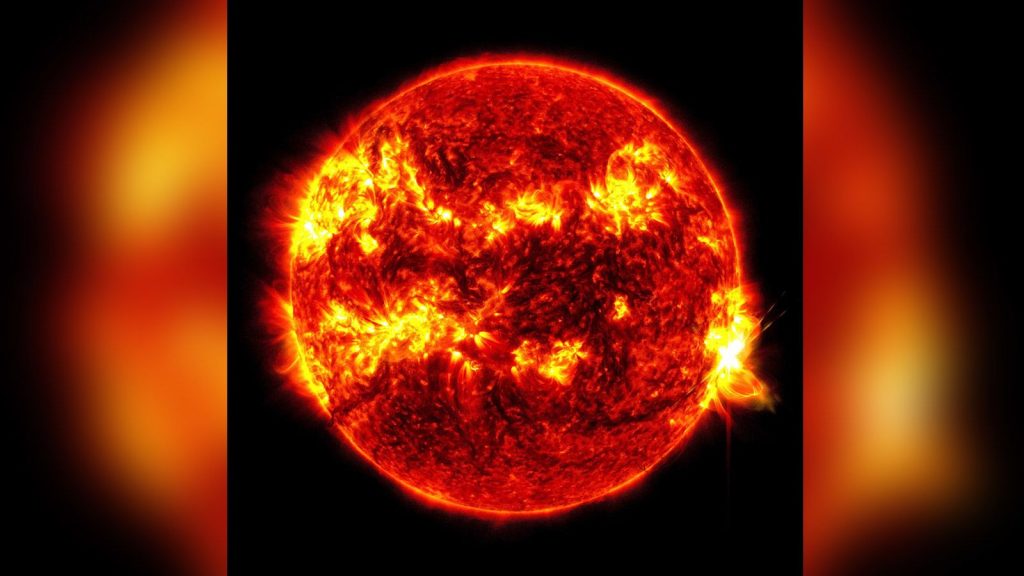The sun emitted its most powerful flare in nearly a decade, just days after severe solar storms created the captivating Aurora Australis in parts of Australia. The effects of this recent blast on Australian skies and technology remain uncertain.
First detected on Tuesday, the solar magnetic storm, also known as a coronal mass ejection, sent energy, light, and particles towards Earth. The National Oceanic and Atmospheric Administration (NOAA) announced, “Not done yet!” after the storm produced another giant flare.
This flare is the largest of an 11-year solar cycle nearing its peak, according to the NOAA. However, the consequences of this event on Earth are still unclear.
Brad Tucker, an astrophysicist at Australian National University, explained that it takes about three days for these solar eruptions to reach Earth due to their speed through space.
Last week’s blast from the storm prompted seven astronauts on the International Space Station to seek shelter in areas with strong radiation shielding. NASA assured that the crew was never in danger. Additionally, the last big solar flare caused one of NASA’s environmental satellites to rotate unexpectedly and enter a hibernation safe-mode due to reduced altitude from the space weather.
Tucker stated that there were “no effects on the ground” in Australia. Satellite systems were monitored, and there didn’t seem to be too much interference. The radiation, which can damage satellites, was not as high as it could have been during the last flare.
NASA’s Solar Dynamics Observatory rated the most recent bright flash as X8.7, the strongest since 2005. This follows nearly a week of flares and mass ejections of coronal plasma that have threatened to disrupt power and communications on Earth and in orbit.
Tucker said that any potential effects of the X8.7 flare on Earth won’t be known for days and will depend on the flare’s “direction and arrival” and how much energy was released during the coronal mass ejection. It appears that the flare erupted on the part of the sun moving away from Earth.
“Even though this latest, fairly powerful, flare was viewed, it was not necessarily aimed at the Earth,” Tucker said. There are currently no warnings from the Bureau of Meteorology about it.
Satellites will continue to be monitored during the latest solar flare’s approach to Earth, in case operations need to be paused or altered. “Given there is a part of the sun that is producing all of these flares, it is definitely something that people are constantly monitoring and paying attention to,” Tucker said.








![Sheikh Khalifa Bin Zayed Al Nahyan Director Mr. Hamis Mohamed (center), ARR Insurance Coast Regional Manager Julie Gaitho (right), AAR Insurance Group Head of Technology Eugene Sanya (left) and students of Al Nahyan participate in planting part of 40,000 trees at the school's compound to mark AAR' 40th anniversary. [Joackim Bwana, Standard]](https://i0.wp.com/cdn.standardmedia.co.ke/images/wysiwyg/images/hnjuNIZaLG82LriAD53nnZAgR18w68QTikMsXCWC.jpg?w=1200&resize=1200,0)


Pingback: SpaceX mission to bring home Starliner astronauts postponed due to hydraulic issue - Esbecgroup
Pingback: 15 Things You Didn't Know About Michael Jordan - Esbecgroup
Pingback: The New Tesla Model Y Is Here. Is It Enough? - Esbecgroup
Pingback: Perovskite Solar Cells Break 31% Efficiency: A Game-Changing Milestone - Esbecgroup
Pingback: Israeli Airstrike on Gaza School Shelter Results in Dozens of Fatalities - Esbecgroup
Модные заметки по выбору отличных образов на любой день.
Заметки профессионалов, новости, все показы и мероприятия.
https://intgez.com/read-blog/60573
Pingback: Uniting Nations for Asteroid Threat: NASA Urges Global Cooperation - Esbecgroup
Pingback: Soaring Temperatures Challenge Muslim Pilgrims during Hajj - Esbecgroup